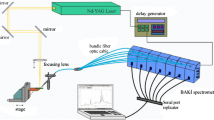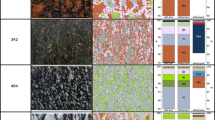Abstract
LIBS is a developing analytical technique, which is used to perform qualitative and semi-quantitative elemental analysis of materials (solid, liquid and gas). Recently LIBS became an attractive technique to be used for geological samples, due to its advantages such as fast data collection and the lack of sample preparation. This study is done to improve analytical methods for geochemical analysis of samples during different exploration phases (Mining, filed analysis, etc.), to be used in the future as a real-time analysis method to save money and time spent in labs. In this work, LIBS has been used to differentiate between some geological samples gathered from different areas: South Africa and Namibia. Using principal component analysis (PCA), it was found that LIBS was able to differentiate between the samples even those of the same area. The results from the LIBS technique were correlated with subsequent analysis of the same samples by Particle-Induced X-ray emission (PIXE).
Similar content being viewed by others
References
D. M. Diaz Pace, N. Gabriele, M. Garcimuno, C. D’Angelo and D. Bertuccelli, “Analysis of Minerals and Rocks by Laser-Induced Breakdown Spectroscopy,” Spectroscopy Letters, pp. 399–411, 2011.
R. Harmon, F. De Lucia, C. McManus, N. McMillan, T. Jenkins, M. Walsh and A. Miziolek, “Laser-Induced Breakdown Spectroscopy - An Emerging Chemical Sensor Technology For Field Portable, Real-time Geochemical, Mineralogical and Environmental Applications,” Application Geochemistry, pp. 730–747, 2006.
C. Mcmanus, N. McMillan, R. Harmon, R. Whitemore, F. DeLucia and A. Miziolek, “The Use of Laser-Induced Breakdown Spectroscopy (LIBS) in the Determination of Gem Provenance,”, pp. G72–G79, 2008.
R. Harmon, J. Remus, N. McMillan, C. McManus, L. Collins, J. Gottfried Jr, F. DeLucia and A. Miziolek, “LIBS Analysis of Geomaterials: Geochemical Fingerprinting for the Rapid Analysis and Discrimination of Minerals,” Applied Geochemistry, pp. 1125–1141, 2009.
M. Gondal, T. Hussain, Z. Yamani and M. Baig, “Detection of Heavy Metals in the Arabian Crude Oil Residue Using Laser-Induced Breakdown Spectroscopy,” Talanta 69, pp. 1072–1078, 2006.
H. Yang, H. Fu, H. Wang, J. Jia, M. Sigrist and F. Dong, “Laser-Induced Breakdown Spectroscopy Applied to the Characterization of Rock by Support Vector Machine Combined with Principal Component Analysis,” Chin. Phys. B Vol. 25. No. 6, 2016.
L. Cabalin and J. Laserna, “Experimental Determination of Laser-Induced Breakdown Spectroscopy Threshold of Metals Under Nanosecond Q-Switched Laser Operation,” Spectrochimica Acta B. Vol 53, pp. 723–730, 1998.
R. McWhirter, “Spectral Intensities,” in Plasma Diagnostic Techniques, New York, Academic, 1965.
A. Striganove and N. Sventitski, Table of Spectral Lines of Neutral and Ionized Atoms, New York, 1968.
R. Harmon, J. Remus, N. McMillan, C. McManus, L. Collins, J. Gottfried Jr., F. DeLucia and A. Miziolek, “LIBS Analysis of Geomaterials: Geochemical Fingerprinting for the Rapid Analysis and Discrimination of Minerals,” Applied Geochemistry. Vol 24, pp. 1125–1141, 2009.
A. Ambushe, A. du Plessis and R. McCrindle, “Laser-Induced Breakdown Spectroscopy and Inductively Coupled Plasma-Mass Spectrometry for Determination of Cr in Soils from Brits District, South Africa,” Bull. Chemical Society of Ethiopia, pp. 357–366, 2015.
L. Radziemski and D. Cremers, Laser-Induced Plasma and Application, New York, 1989.
M. Kasem and M. Harith, “Laser-Induced Breakdown Spectroscopy in Africa,” Journal of Chemistry, pp. 1–10, 2015.
E. Manikaden, G. Kavita, P. Magudapathy, B. Rajamannan and B. Prithviraj, “2 MeV PIXE Technique for Coastal Material Analysis,” International Journal of PIXE, pp. 75–86, 2011.
J. Maxwell, W. Teesdale and J. Campbell, “The Guelph GUPIX Software Package IT,” Nucl. Instr and Meth B Vol 95, p. 407, 1995.
S. Johannson and K. Bartfoot, PIXE: A Novel Technique for Elemental Analysis, Chichester: Wiley, 1988.
NIST, NIST Electronic Data Base for Neutral and Ionized Elements, Available at https://physics.nist.gov/PhysRefData/ASD/lines_form.html, Accessed 5 April 2017.
L. Railsback, “An Earth Scientist Periodic Table of the Elements and Their Ions,” Geology. Vol 39 (9), pp. 373–740, 2003.
B. Yardly and R. Bodnar, “Fluids in the Continental Crust,” Geochemical perspectives. Vol 3 (1), pp. 1–127, 2014.
C. Ryan, F. Clayton, W. Griffin, S. Sie and D. Cousens, “Snip, A Statistical - Sensitive Background Treatment for the Quantitative Analysis of PIXE Spectra in the Geoscience Applications,” Nuclear Instruments and Methods in Physics Research B34, pp. 396–402, 1998.
J. Walsh, “Determination of Silica in Rocks and Minerals by a Combined Gravimetric and Atomic - Absorption Spectrophotometric Procedure,” Analyst, pp. 51–54, 1977.
D. Johnson, P. Hooper and R. Conrey, “XRF Analysis of Rocka and Minerals for Major and Trace Elements On a Single Low Dilution Li-tetraborate Fused Bead,” International Centre for Diffraction Data, pp. 843–867, 1999.
R. Ravisankar, A. Rajalakshmi, P. Eswaran, V. Meenakashisundram, V. Gajendiran, E. Manikandan, P. Magudapathy, P. Panigrahi and K. Nair, “Gamma -Ray Spectroscopic and PIXE Analysis of Beach Rock Samples of South East Coast of Tamilnadu, India,” International Journal of PIXE Vol 17, pp. 193–203, 2007.
J. Gottfried, R. Harmon, F. De Lucia and A. & Miziolek, “Multivariate Analysis of Laser-Induced Breakdown Spectroscopy Chemical Signatures for Geomaterial Classification,” Spectrochimica Acta B, pp. 1009–1019, 2009.
D. Death, A. Cunningham and L. Pollard, “Multi-Element and Mineralogical Analysis of Mineral Ores Using Laser-Induced Breakdown Spectroscopy and Chemometric Analysis,” Spectrochima Acta Part B Vol 64, pp. 1048–1058, 2009.
N. McMillan, S. Rees, K. Kocjelek and C. McManus, “Geological Applications of Laser-Induced Breakdown Spectroscopy,” Geostandards and Geoanalytical Research Vol 38, pp. 329–343, 2014.
M. Ibrahim, A. Hussein, A. Osman and I. Ibrahim, “Uranium Geochemistry in Paraluminous Leucogranites of Wadi El-Shallal Area, Sinai, Egypt,” Journal of Earth Science Vol 12, pp. 17–37, 2000.
D. Alvey, K. Morton, R. Harmon, J. Gottfried, J. Remus, M. Collins and M. Wise, “Laser-Induced Breakdown Spectroscopy- Based Geochemical Fingerprinting for the Rapid Analysis and discrimination of minerals: The Example of Garnet,” Applied Optics. Vol 49, pp. C168–C180, 2010.
E. Harby and A. Olodia, “From Ptolemaic to Modern Inked Linen via Laser-Induced Breakdown Spectroscopy (LIBS),” Analytical Methods. Vol 5, pp. 3114–3121, 2013.
A. Kiros, V. Lazic, G. Gigante and A. Gholap, “Analysis of Rock Samples Collected from Rock-Hewn Churches of Lalibela, Ethiopia using Laser-Induced Breakdown Spectroscopy,” Journal of Archaeological Science, pp. 2570–2578, 2013.
Author information
Authors and Affiliations
Corresponding author
Rights and permissions
About this article
Cite this article
Panya panya, S.N., Galmed, A.H., Maaza, M. et al. Laser-Induced Breakdown Spectroscopy (LIBS) on Geological Samples: Compositional Differentiation. MRS Advances 3, 1969–1983 (2018). https://doi.org/10.1557/adv.2018.401
Published:
Issue Date:
DOI: https://doi.org/10.1557/adv.2018.401




